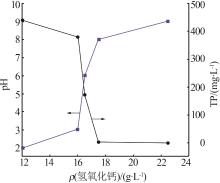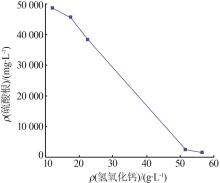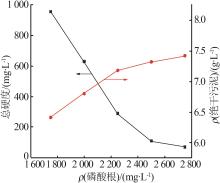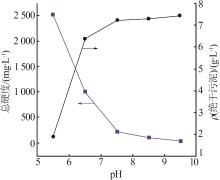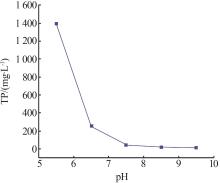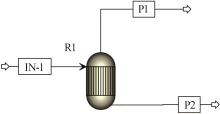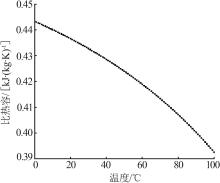Inorganic Chemicals Industry ›› 2024, Vol. 56 ›› Issue (8): 99-103.doi: 10.19964/j.issn.1006-4990.2023-0568
• Environment·Health·Safety • Previous Articles Next Articles
Study on pretreatment of iron phosphate production wastewater reuse and zero discharge
WANG Wei1,2( ), LI Wei1,2, LI Limin1, LIU Dongxu1
), LI Wei1,2, LI Limin1, LIU Dongxu1
- 1.Beijing Novel Environmental Protection Co. , Ltd. , Beijing 100020, China
2.ENN Envirotech Co. , Ltd. , Langfang 065001, China
-
Received:2023-11-29Online:2024-08-10Published:2024-09-26
CLC Number:
Cite this article
WANG Wei, LI Wei, LI Limin, LIU Dongxu. Study on pretreatment of iron phosphate production wastewater reuse and zero discharge[J]. Inorganic Chemicals Industry, 2024, 56(8): 99-103.
share this article
| 1 | 陈海生,李泓,马文涛,等.2021年中国储能技术研究进展[J].储能科学与技术,2022,11(3):1052-1076. |
| CHEN Haisheng, LI Hong, MA Wentao,et al.Research progress of energy storage technology in China in 2021[J].Energy Storage Science and Technology,2022,11(3):1052-1076. | |
| 2 | 张英杰,许斌,梁风,等.废旧磷酸铁锂电池正极材料的回收研究现状[J].人工晶体学报,2019,48(5):800-808. |
| ZHANG Yingjie, XU Bin, LIANG Feng,et al.Review on recycling cathode materials of spent lithium iron phosphate batteries[J].Journal of Synthetic Crystals,2019,48(5):800-808. | |
| 3 | 伍德佑,刘志强,饶帅,等.废旧磷酸铁锂电池正极材料回收利用技术的研究进展[J].有色金属(冶炼部分),2020(10):70-78. |
| WU Deyou, LIU Zhiqiang, RAO Shuai,et al.Research progress in recycling technology of cathode materials for spent lithium iron phosphate batteries[J].Nonferrous Metals(Extractive Metallurgy),2020(10):70-78. | |
| 4 | 郭举.钛白渣提纯制备电池级硫酸亚铁工艺技术研究[J].无机盐工业,2019,51(8):48-51. |
| GUO Ju.Study on preparation of battery⁃grade ferrous sulfate by purification of titanium white slag[J].Inorganic Chemicals Industry,2019,51(8):48-51. | |
| 5 | ZHAO Junhong, ZHANG Youjuan, Zhen RUN,et al.Ferric phosphate hydroxide microstructures affect their magnetic properties[J].Chemistry Open,2015,4(3):274-277. |
| 6 | 张博,李菲.磷酸铁综合废水资源化处理装置及其方法:中国,105000725A[P].2015-10-28. |
| 7 | 车林轩,程伟钊,韦志鹏.污水除磷技术及影响因素的研究进展[J].应用化工,2022,51(6):1811-1816,1824. |
| CHE Linxuan, CHENG Weizhao, WEI Zhipeng.The research and development of technologies for wastewater phosphorus removal and its influencing factors[J].Applied Chemical Industry,2022,51(6):1811-1816,1824. | |
| 8 | 李雅,刘晨明,刘凤梅,等.分步沉淀去除磷酸铁生产废水中的磷酸根和硫酸根[J].化工环保,2018,38(4):413-418. |
| LI Ya, LIU Chenming, LIU Fengmei,et al.Removal of phosphate radical and sulfate radical from ferric phosphate production wastewater by stepwise precipitation[J].Environmental Protection of Chemical Industry,2018,38(4):413-418. | |
| 9 | 黄高鑫,唐玉朝,伍昌年,等.吸附-磷酸铵镁结晶耦合法去除低浓度氨氮[J].精细化工,2022,39(7):1464-1472,1512. |
| HUANG Gaoxin, TANG Yuchao, WU Changnian,et al.Low concentration ammonia nitrogen removal via adsorption⁃struvite crystallization coupling method[J].Fine Chemicals,2022,39(7):1464-1472,1512. | |
| 10 | 郑冰玉,张树军,杨岸明.磷酸铵镁结晶法用于污水处理流程中磷元素回收进展[J].环境工程,2019,37(6):90-95. |
| ZHENG Bingyu, ZHANG Shujun, YANG Anming.Progress of phosphorus recovery in wastewater treatment by magnesium ammonium phosphate(map) crystallization[J].Environmental Engineering,2019,37(6):90-95. | |
| 11 | 赵辉.低含磷废水处理方法研究进展[J].化工环保,2023,43(3):292-297. |
| ZHAO Hui.Research progress on treatment of low phosphorus wastewater[J].Environmental Protection of Chemical Industry,2023,43(3):292-297. | |
| 12 | 韦传旭,孙可纯,程雪剑,等.磷酸铵镁结晶法回收村镇垃圾中转站渗滤液氨氮[J].中国给水排水,2023,39(23):8-14. |
| WEI Chuanxu, SUN Kechun, CHENG Xuejian,et al.Nitrogen recovery in rural waste transfer station leachate by magnesium ammonium phosphate crystallization process[J].China Water & Wastewater,2023,39(23):8-14. | |
| 13 | 郑秀军.膜分离技术在磷酸净化中的应用[J].磷肥与复肥,2020,35(3):22-24. |
| ZHENG Xiujun.Application of membrane separation technology in WPA purification[J].Phosphate & Compound Fertilizer,2020, 35(3):22-24. | |
| 14 | 刘茂举,龚福忠,铁云飞,等.反渗透膜法处理磷酸铁生产废水的零排放工艺研究[J].无机盐工业,2021,53(8):101-105. |
| LIU Maoju, GONG Fuzhong, Yunfei TIE,et al.Study on reverse osmosis membrane process with zero⁃discharge for treating of wastewater from iron phosphate production[J].Inorganic Chemicals Industry,2021,53(8):101-105. | |
| 15 | 熊攀.光卤石—磷酸盐法锂镁分离新工艺研究[D].成都:成都理工大学,2019. |
| XIONG Pan.A new process for separating lithium and magnesium by the carnallite⁃phosphate method[D].Chengdu:Chengdu University of Technology,2019. | |
| 16 | 雷泽宇.稀土镁合金与活性炭电极强化电解猪场废水工艺研究[D].杭州:浙江大学,2022. |
| LEI Zeyu.Study on enhanced electrolysis of swine wastewater with rare earth Mg alloy and activated carbon electrode[D].Hangzhou:Zhejiang University,2022. |
| [1] | SHI Yunpeng, GUO Ze, ZHANG Hanquan, LU Manman. Study on treatment of ammonia nitrogen wastewater by roasted phosphorus tailings [J]. Inorganic Chemicals Industry, 2025, 57(3): 94-100. |
| [2] | ZHANG Li, LOU Yufeng, ZHANG Wei, LIU Fangwang, LAN Jing, ZHAO Zongshan, FU Kunming. Research of regeneration of thioglycolic acid by bipolar membrane electrodialysis using sodium thioglycolate wastewater as resource [J]. Inorganic Chemicals Industry, 2025, 57(2): 120-129. |
| [3] | WEN Huizi, XI Luyao, HE Shuyu, TAN Shanyi, ZHANG Liwen, CHEN Shaohua, DU Yaguang. Research on Na2CO3 enhanced food additive wastewater hydrothermal wet reduction and detoxification of chromite ore processing residue [J]. Inorganic Chemicals Industry, 2025, 57(1): 83-89. |
| [4] | YUAN Yaosen, LI Enze, LÜ Hongzhou, SONG Yipeng, YANG Chengli, LI Juanjuan. Study on application of spray⁃drying method in inorganic salt recovery and organic matter decomposition in high salt organic wastewater [J]. Inorganic Chemicals Industry, 2024, 56(8): 83-91. |
| [5] | DENG Guoping, WU Yong, DUAN Lizhong, REN Zhi, WU Lixin. Research on process of preparing sodium fluoride from waste liquid containing fluorine as resource [J]. Inorganic Chemicals Industry, 2024, 56(6): 133-138. |
| [6] | WANG Junting, MA Hang, ZHA Zuotong, WAN Banglong, ZHANG Zhenhuan. Research progress of iron phosphate industrial wastewater treatment process [J]. Inorganic Chemicals Industry, 2024, 56(6): 26-33. |
| [7] | ZHU Zuoqiao, SHI Mengyuan, MAO Rui, GUO Haining, SU Yuao. Study on treatment process of metallurgical fluorine-containing wastewater by coagulant sedimentation method [J]. Inorganic Chemicals Industry, 2024, 56(4): 118-124. |
| [8] | ZHAO Runze, QIAN A′niu. Research progress of lithium recovery for spent lithium-ion batteries and preparation in battery-grade lithium carbonate [J]. Inorganic Chemicals Industry, 2024, 56(12): 70-78. |
| [9] | HUANG Zhaojie, ZHAO Xiaoxu, WANG Haitao, CHANG Na, ZHANG Guoxin, XIE Yonglei, YIN Yanmei, LU Na, WANG Wei. Study on ultrafiltration+nanofiltration double membrane treatment of iron process iron phosphate production wastewater [J]. Inorganic Chemicals Industry, 2024, 56(11): 145-150. |
| [10] | LI Ping, LI Jun, CHEN Ming. Study on process of recovery of Fe(Ⅲ) from spent lithium extractant and preparation of battery grade iron phosphate [J]. Inorganic Chemicals Industry, 2024, 56(10): 28-37. |
| [11] | MA Yihong, CHEN Xingtao, TANG Lei. Treatment of printing wastewater by chemical coagulation-TiO2/g-C3N5 photocatalytic degradation [J]. Inorganic Chemicals Industry, 2024, 56(10): 151-158. |
| [12] | WEI Tianshun, JI Lijun, SHENG Yong, CHEN Kui, WU Yanyang, WU Bin. Study on fractional crystallization process of ammonium sulfate and sodium sulfate in high salt wastewater [J]. Inorganic Chemicals Industry, 2024, 56(1): 102-106. |
| [13] | LI Yang, ZANG Yihua, YUAN Biao, SHENG Chunguang. Modification of antifouling ceramic membrane and its application of oily wastewater treatment [J]. Inorganic Chemicals Industry, 2023, 55(9): 33-42. |
| [14] | WANG Yingnan, SHENG Linlin, HUANG Juan, HUANG Zhanbin. Study on adsorption performance of lead from water by coal-fired slag [J]. Inorganic Chemicals Industry, 2023, 55(8): 109-115. |
| [15] | CHEN Zhangxu, ZHU Danchen, FU Minglian. Study on preparation of g-C3N4/TiO2 composites and application for rhodamine B removal [J]. Inorganic Chemicals Industry, 2023, 55(7): 130-136. |
| Viewed | ||||||
|
Full text |
|
|||||
|
Abstract |
|
|||||
|
||
